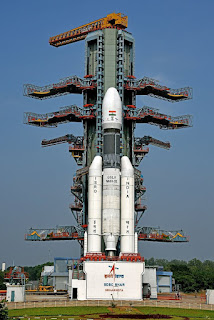Chandrayaan 2 Mission
 |
| Chandrayaan 2 Mission |
Chandrayaan 2 Mission
Introduction:
In
September 2019, the Indian Space Research Organisation (ISRO) launched
Chandrayaan-2, the country’s second lunar mission after Chandrayaan-1. This
mission was a significant achievement for India’s space program, as it aimed to
demonstrate the country’s technological prowess in space exploration.
Objectives:
The
primary objective of Chandrayaan-2 was to land a rover on the moon’s south pole
region and conduct scientific experiments to study the lunar surface and its
geology. The mission aimed to collect data on the moon’s mineralogy, water content,
and lunar seismic activity. The secondary objective was to explore the
potential for the presence of water ice on the moon’s surface.
Components
of Chandrayaan-2:
The
orbiter, lander, and rover of Chandrayaan-2 were three separate spacecraft. The
orbiter, which was created to circle the moon and perform remote sensing
measurements of the lunar surface, had a one-year mission life. It was equipped
with eight scientific payloads for exploring the moon’s atmosphere, surface,
and exosphere.
The
lander, which was given the name Vikram in honour of the Indian Space Research
Organisation’s founder, was made to land gently on the moon’s surface. It was
equipped with three scientific payloads for both surface- and subsurface-level
research. The Pragyan rover, which could move up to 500 metres on the lunar
surface, was housed inside the lander. Two scientific payloads were loaded onto
it for in-situ surface analysis.
Launch
and Mission Timeline:
Chandrayaan-2
was launched on July 22, 2019, aboard the GSLV Mark III rocket from the Satish
Dhawan Space Centre in Sriharikota, India. The mission took 48 days to travel
to the moon’s orbit, covering a distance of 3.84 lakh kilometers.
On
September 2, 2019, the lander Vikram was separated from the orbiter and began
its descent towards the lunar surface. However, during the final descent phase,
communication with the lander was lost, and it crash-landed on the moon’s
surface.
The
orbiter, however, successfully entered the moon’s orbit and began its
scientific mission. It continues to orbit the moon, sending back valuable data
and images of the lunar surface.
Scientific
Discoveries:
Chandrayaan-2’s
scientific payloads have provided valuable data on the moon’s surface and its
geology. The orbiter’s imaging payload has captured high-resolution images of
the lunar surface, providing new insights into the moon’s topography, geology,
and mineralogy.
The
orbiter’s other scientific payloads, including the dual-frequency synthetic
aperture radar (SAR), the X-ray spectrometer (CXS), and the solar X-ray monitor
(XSM), have provided data on the moon’s subsurface structure, the distribution
of elements, and the lunar exosphere’s dynamics.
Chandrayaan-2’s
scientific discoveries have also shed light on the potential presence of water
ice on the moon’s surface. The orbiter’s imaging payload has detected water
molecules in the moon’s polar regions, indicating the possibility of water ice.
Conclusion:
Chandrayaan-2 was a significant achievement for India’s space program, showcasing the country’s technological prowess in space exploration. While the lander’s crash-landing was a setback, the orbiter’s scientific payloads have provided valuable data and insights into the moon’s surface and its geology. Chandrayaan-2’s legacy will continue to inspire future space missions and scientific discoveries.






No comments